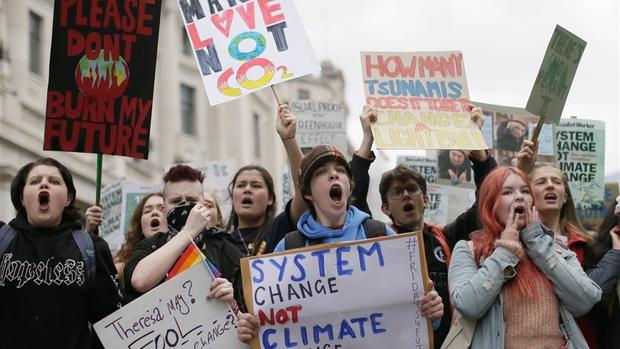 Demonstrators hold placards during a protest by young people calling for action on climate change in London, on April 12, 2019. (TIM IRELAND / XINHUA)
Demonstrators hold placards during a protest by young people calling for action on climate change in London, on April 12, 2019. (TIM IRELAND / XINHUA)
A deadly "big freeze" in the United States, heavy snowfalls in Southern Europe and the Middle East, melting glaciers in the two poles and the Himalayas, with fatal consequences in India. The loss of life incurred over recent weeks in phenomena linked to climate change underscores the stakes as the planet warms.
"These disasters represent clear and present danger. They are here, they are now, and they take lives and livelihoods. They should flag the urgency of acting now," said Vinod Thomas, visiting professor at the Lee Kuan Yew School of Public Policy in the National University of Singapore.
ALSO READ: Global ice melt matches worst-case climate scenario, study says
These disasters represent clear and present danger. They are here, they are now, and they take lives and livelihoods. They should flag the urgency of acting now.
Vinod Thomas, visiting professor at the Lee Kuan Yew School of Public Policy in the National University of Singapore
Scientists have for long warned about the growing impact of global warming. It seems "counterintuitive when we talk about a warming planet then we have these abnormal cold conditions", said professor Will Steffen, spokesman for the Climate Council in Australia.
The abnormal winter snowstorms and freezing temperatures that cut a crippling swathe through large parts of the US led to at least 70 deaths and left millions to shiver without electricity and drinking water. US President Joe Biden declared a major disaster in Texas on Saturday and much of the state got warmer weather on Sunday. Relief supplies are being shipped in.
"What we are seeing in the US is a rush of cold air sweeping down from the Arctic," Steffen said.
Usually that cold air is held there by what's known as the jet stream, which runs around the Arctic in a latitude roughly through the middle of Canada and Siberia. In normal times, there is a strong temperature gradient between the hot equator and the cold Arctic.
But now, "the gradient between the equator and the North Pole is weakening and cold air brakes through. When that happens, it drags warm air up", Steffen said.
The freeze produced by this effect has spread far. The heavy snowfalls in Europe and the Middle East have blanketed ancient monuments in Athens, and halted many services in Libya, Lebanon, Jordan, Syria, Saudi Arabia and Israel.
However, Steffen said there can be no argument about climate change. "While much of the planet is getting warmer, the Arctic is warming at twice the global average," he said.
Jennifer Francis, a senior scientist at Woodwell Climate Research Center in the US, said the harsh weather in parts of the US "is consistent with research that has connected what is happening in the Arctic with extreme weather patterns in the mid-latitudes".
A special report by the United Nations' Intergovernmental Panel on Climate Change on oceans and the cryosphere shows climate change has altered the frequency and magnitude of the natural hazards, said Anjal Prakash, coordinating lead author of a 2018 special report by the UN's climate body.
If the world can keep the global temperature rise to below 1.5 C, in the Hindu Kush Himalaya region that would translate to an increase of at least 1.8 C and, in some places, above 2.2 C, said Prakash, research director of the Bharti Institute of Public Policy at the Indian School of Business.
On Feb 7 a Himalayan glacier broke apart and triggered a major flash flood in northern India, killing at least 67 people.
READ MORE: Call for global action on climate change
Li Dewen, professor at the National Institute of Natural Hazards within China's Ministry of Emergency Management, said the causes of India's glacier burst could be various.
The impact of global warming can be more readily seen in some areas, and dynamic monitoring with sensor technologies in sensitive areas can help, Li said.
Thomas said: "The one good purpose this extreme weather can serve is to help policymakers and the public to connect the dots and act."
On Friday, the US returned to the Paris Agreement on climate, 107 days after it left.
Contact the writers at karlwilson@chinadailyapac.com


